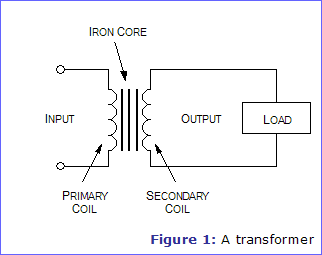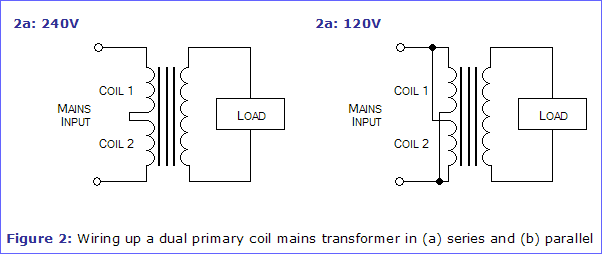
Transformers
By John Hewes
A transformer consists of two coils (often called 'windings') linked by an iron core, as shown in figure 1. There is no electrical connection between the coils, instead they are linked by a magnetic field created in the core.

Transformers are used to convert electricity from one voltage to another with minimal loss of power. They only work with AC (alternating current) because they require a changing magnetic field to be created in their core. Transformers can increase voltage (step-up) as well as reduce voltage (step-down).
Alternating current flowing in the primary (input) coil creates a continually changing magnetic field in the iron core. This field also passes through the secondary (output) coil and the changing strength of the magnetic field induces an alternating voltage in the secondary coil. If the secondary coil is connected to a load the induced voltage will make an induced current flow. The correct term for the induced voltage is 'induced electromotive force' which is usually abbreviated to induced e.m.f.
The iron core is laminated to prevent 'eddy currents' flowing in the core. These are currents produced by the alternating magnetic field inducing a small voltage in the core, just like that induced in the secondary coil. Eddy currents waste power by needlessly heating up the core but they are reduced to a negligible amount by laminating the iron because this increases the electrical resistance of the core without affecting its magnetic properties.
Transformers have two great advantages over other methods of changing voltage:
| |
 |
Mains transformers are the most common type. They are designed to reduce the AC mains supply voltage (230-240V in the UK or 115-120V in some countries) to a safer low voltage. The standard mains supply voltages are officially 115V and 230V, but 120V and 240V are the values usually quoted and the difference is of no significance in most cases.

To allow for the two supply voltages mains transformers usually have two separate primary coils (windings) labelled 0-120V and 0-120V. The two coils are connected in series for 240V (figure 2a) and in parallel for 120V (figure 2b). They must be wired the correct way round as shown in the diagrams because the coils must be connected in the correct sense (direction):

Most mains transformers have two separate secondary coils (e.g. labelled 0-9V, 0-9V) which may be used separately to give two independent supplies, or connected in series to create a centre-tapped coil (see below) or one coil with double the voltage.
Some mains transformers have a centre-tap halfway through the secondary coil and they are labelled 9-0-9V for example. They can be used to produce full-wave rectified DC with just two diodes, unlike a standard secondary coil which requires four diodes to produce full-wave rectified DC.
| Further Information | The Rectifier |
A mains transformer is specified by:
![[Equation] [Equation]](equations/027_01.gif)
...where Vs is the secondary voltage. If there are two secondary coils the maximum power should be halved to give the maximum for each coil.
Audio transformers are used to convert the moderate voltage, low current output of an audio amplifier to the low voltage, high current required by a loudspeaker. This use is called 'impedance matching' because it is matching the high impedance output of the amplifier to the low impedance of the loudspeaker.

Radio transformers are used in tuning circuits. They are smaller than mains and audio transformers and they have adjustable ferrite cores made of iron dust. The ferrite cores can be adjusted with a non-magnetic plastic tool like a small screwdriver. The whole transformer is enclosed in an aluminium can which acts as a shield, preventing the transformer radiating too much electrical noise to other parts of the circuit.

The ratio of the number of turns on the primary and secondary coils determines the ratio of the voltages...
![[Equation] [Equation]](equations/027_02.gif)
...where Vp is the primary (input) voltage, Vs is the secondary (output) voltage, Np is the number of turns on the primary coil, and Ns is the number of turns on the secondary coil.
The very small power loss in a transformer means that we can assume that power in = power out. Power = voltage x current, so we can use this to show that the current ratio is the inverse of the voltage ratio. For equal power the current increases as the voltage decreases...
![[Equation] [Equation]](equations/027_03.gif)
so...
![[Equation] [Equation]](equations/027_04.gif)
...where Ip is the primary (input) current, and Is is the secondary (output) current.
The current in the primary coil Ip is determined almost entirely by the current Is drawn by the load connected to the secondary coil. With no load connected, Is = 0 and Ip is very small indeed because the alternating magnetic field created by the primary current induces a voltage in the primary coil which almost exactly matches the supply voltage. If a load is connected current will flow in the secondary coil, creating a magnetic field which opposes and partly cancels out the field created by the primary coil. The resulting weakened field induces a smaller voltage in the primary coil to oppose the supply voltage and this means that a larger primary current flows.
Article Information
Source: Electronics in Meccano - www.eleinmec.com
Topic: Components Explained |
Created: 10/04/2003 |
Last modified: 13/02/2007
Top of Page | Homepage | About | Search | Topics | Features | Circuits Shop | yourEiM |
© 1998 - 2024 Tim Surtell |